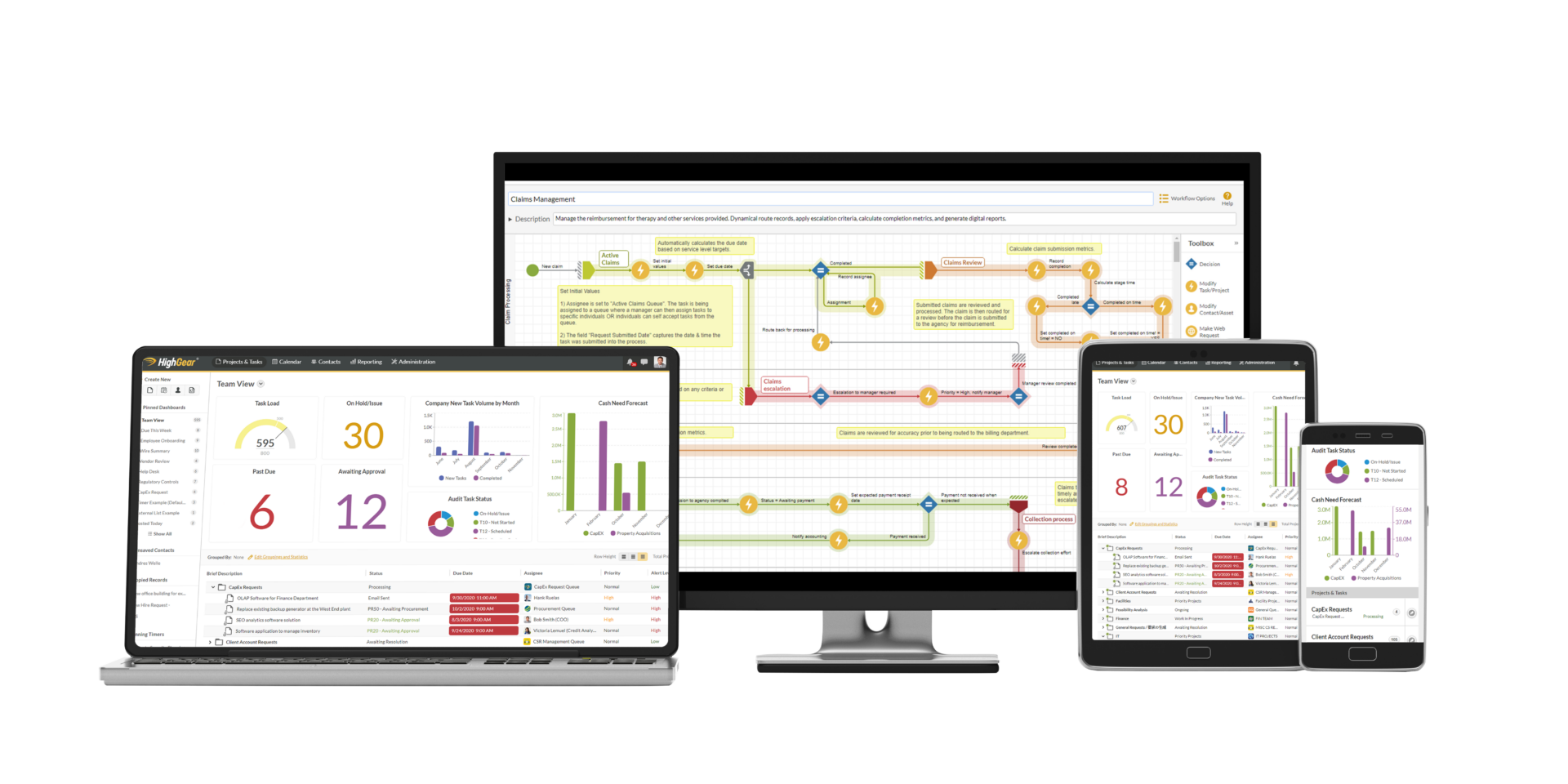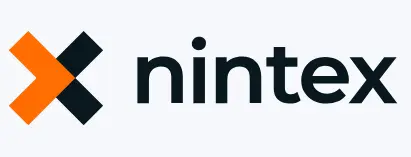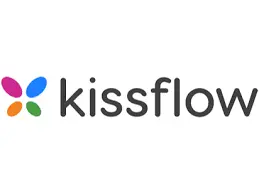Trying to find the best workflow management software for your business can seem like a daunting task. This is mainly due to the sheer volume of software options available on the market. In this article, we’ll discuss some of the best platforms on the market in detail to help you find the very best fit for your business.
Best Workflow Management Software Tools Compared
We’ve created a comprehensive table comparing our top 7 workflow management solution choices.
| Software | No-Code | Pricing | Client Rating |
| HighGear | Yes | From $63/month per licensed contributor | 5 out of 5 stars |
| Nintex | No | Annual subscriptions begin at $25,000 | 4.1 out of 5 stars |
| Integrify | No | Monthly plans start at $875 | 4.5 out of 5 stars |
| Decisions | No | By Request Only | 4.4 out of 5 stars |
| ServiceNow | No | Starting at $100 per user/month | 4.5 out of 5 stars |
| Appian | No | Monthly user pricing starts at $75 | 4.2 out of 5 stars |
| Kissflow | No | Starting at $1,500 monthly | 4.1 out of 5 stars |
7 Best Workflow Management Solutions for 2024
There are many different things to consider when trying to choose the best workflow management tool for your organization. Some of these include usability, customization, feature set, compatibility with existing systems, ability to support collaboration and scalability. Below, we’ll look at some tools that fit into these criteria.
1 – HighGear
HighGear is one of the only no-code workflow management tools on the market. Our focus is making business automation and workflow management tools accessible to every type of enterprise.

Our platform requires no coding, is easy to use, and has many intuitive features. This allows you to visualize, analyze, modify, and deploy workflows without bothering the IT department.
The key features of the HighGear workflow management system include the following:
- Effortless Workflow Automation (No-Code): HighGear distinguishes itself from other workflow management tools through its intuitive, no-code interface. This eliminates the need for prior coding knowledge, empowering users to construct and implement custom workflows in a fraction of the time typically required by traditional solutions.
- Drag-and-Drop Visual Workflow Designer: HighGear’s intuitive visual workflow software empowers users to design and visualize business processes with unprecedented ease. This user-friendly platform enables the rapid construction of custom workflows without the need for external IT involvement, fostering agility and operational efficiency.
- Intuitive Drag-and-Drop Forms: HighGear empowers administrators to construct custom forms with ease. Our intuitive drag-and-drop form builder allows the creation of automated workflows without the need for programming expertise, promoting user ownership and streamlined data collection.
- In-Depth Reporting & Analytics: HighGear equips users with robust reporting and analytics functionalities. This empowers them to access comprehensive, real-time, and customizable reports, facilitating data-driven decision-making and optimizing operational efficiency.
- Seamless App & System Connectivity: HighGear boasts native integrations with a vast ecosystem, including more than 5,000 different applications and platforms. These include industry leaders like Zapier, HubSpot, Office 365, Salesforce, and Okta. This empowers you to effortlessly construct custom integrations, streamline your workflows, and foster data exchange across your business applications.
2 – Nintex
Nintex is undoubtedly one of the most popular workflow management and automation tools, thanks to its large ecosystem and wealth of available tools.

That being said, the system is much more complex compared to HighGear, requiring users to have refined technical skills to fully utilize the platform. It features workflow management tools including:
- Visual Drag-and-Drop Workflow Studio: Nintex empowers developers to rapidly create, deploy, and map customized business workflows through its drag-and-drop workflow designer.
- Seamless Microsoft Integration: Leveraging its deep integration with Microsoft solutions, Nintex unlocks robust automation capabilities for business users. This empowers them to automate tasks and optimize workflows within their existing Microsoft ecosystem.
- Optimized Mobile Experience: Like HighGear, Nintex prioritizes a seamless mobile experience. Its platform offers exceptional mobile optimization for both iOS and Android devices, ensuring accessibility and flexibility for on-the-go users.
3 – Integrify
Integrify is a powerful workflow management tool. Unfortunately, users require at least some basic coding skills to use the custom workflows. Barring that, users might find themselves limited by the parameters of pre-built workflows.

While the tool doesn’t feature HighGear’s no-code approach, it’s still a powerful platform. Some key features incorporated into the Integrify workflow management platform include:
- Drag-and-Drop Workflow Design Studio: Integrify has an intuitive drag-and-drop workflow builder. This user-friendly interface enables the rapid construction of end-to-end workflows, facilitating task assignments and multi-tiered approval structures.
- User-Accessible Automation: Integrify prioritizes accessibility through a low-code approach. This approach minimizes the learning curve and empowers users with basic coding experience (JavaScript and CSS) to craft, manage, and automate business processes independently.
- Flexible Custom Form Builder: Integrify differentiates itself through its versatile custom form designer. This tool allows users to construct forms, either from scratch or by leveraging pre-built templates.
- Robust Open API Integrations: Integrify leverages open APIs, facilitating seamless integration with thousands of applications.
4 – Decisions
Decisions is one of the more well-known players in the workflow management space. If your users are equipped with coding knowledge, it may be the right fit for you.

The Decisions workflow management system includes the following key features:
- Intuitive Visual Workflow Design: Akin to HighGear, Decisions leverages a visual paradigm for workflow construction. Its user-friendly Design Studio app empowers trained administrators and IT professionals to craft, manage, and optimize complex, enterprise-grade workflows with efficiency.
- Intelligent Automation Engine: Decisions utilizes cutting-edge AI solutions, enabling users with minimal coding experience to automate tasks and workflows rapidly.
- Scalable Architecture: Decisions emphasizes its platform’s ability to seamlessly scale across organizations of varying sizes.
- Extensive Integration Capabilities: Decisions boasts a robust integration infrastructure, supporting connections with various web services, enterprise applications, and databases. This fosters seamless data exchange and facilitates the creation of unified business processes.
5 – ServiceNow
ServiceNow has a very IT-centric approach to workflow and business management. While it is a powerful tool, this approach means the tool is far more complex to deploy than a no-code solution like HighGear.

If you don’t find the complexity and learning curve daunting, the ServiceNow platform for workflow management provides key features like:
- Intuitive Visual Workflow Design: Similar to HighGear, ServiceNow leverages a visual workflow designer to facilitate the intuitive construction of custom processes. While offering robust functionalities, the platform caters primarily to users with some technical proficiency.
- Comprehensive Real-Time Performance Data: ServiceNow equips users with comprehensive reporting and analytics features, providing in-depth insights into workflow performance. While the granularity of data may require focused analysis for optimal utilization, it empowers data-driven decision-making and continuous improvement.
- Flexible Deployment Options: Aligned with HighGear, ServiceNow offers both on-premise and cloud deployment options, granting businesses greater flexibility in integrating teams, workflows, and data, fostering adaptation to diverse organizational needs.
- Extensive Integration Library: While ServiceNow’s third-party app and system integration process might require some initial investment, it offers an impressive selection of pre-built connectors, including industry leaders like Salesforce, Oracle, and Workday. This enables streamlined data exchange across various business applications.
6 – Appian
You almost can’t look into workflow management tools without encountering Appian. This simplistic, low-code platform has much to recommend. However, when compared to HighGear’s no-code approach, it’s considerably more complex since you still need coding knowledge.

It’s still a good choice if you’re looking for some basic key features, and the Appian workflow management tool offers the following:
- Visual Workflow Design: Appian, similar to HighGear, leverages a visual paradigm for workflow construction. While its intuitive designer caters to a broader audience, developers are required to utilize its advanced functionalities and unlock the full potential for power users seeking a comprehensive development environment.
- Automated Process Mapping: Appian empowers users to map and optimize business processes through its robust automation features. For instance, during workflow deployment, the platform automatically creates a secure container encompassing all relevant data and permissions, streamlining the development lifecycle.
- Real-Time Performance Visibility: Appian’s platform provides comprehensive reporting capabilities, encompassing a user-friendly report builder capable of generating basic grids and data visualizations. These features offer real-time insights into workflow performance, enabling continuous improvement and optimization.
- Extensive Integration Ecosystem: Appian boasts a rich ecosystem of pre-built integrations, including leading solutions like Salesforce, DocuSign, and AWS. Additionally, the platform supports the development of custom integrations utilizing Open API standards, enabling seamless data exchange with external systems.
7 – Kissflow
Kissflow is a fairly well-known platform in the workflow management sphere. However, like most other options on this list, you still need basic coding skills to fully benefit from this tool.

Kissflow’s workflow management system offers an array of features, including:
- Intuitive Drag-and-Drop Workflow Builder: Kissflow empowers business users to design and deploy custom workflows with ease through its intuitive drag-and-drop builder. This visual interface simplifies process creation, fostering user adoption and rapid workflow implementation.
- Robust Analytics and Reporting Features: Kissflow equips business users and management with powerful analytics capabilities, enabling real-time reporting and instant access to key performance insights (KPIs). This data-driven approach facilitates informed decision-making and continuous workflow optimization.
- Extensive Integration Library: Kissflow boasts a comprehensive library of pre-built integrations, empowering users to seamlessly connect the platform with a wide range of popular business applications, including Slack, Mailchimp, and Salesforce. This robust integration capability streamlines data exchange and fosters a unified business ecosystem.
Advantages of Workflow Software Tools
Is it really worth investing in workflow management tools? Yes, because they offer a range of benefits and advantages. Some of these include the following:
- Streamlined processes: Workflow tools help automate repetitive tasks, eliminating manual work and freeing up time for more important activities.
- Reduced errors: By automating tasks and providing clear instructions, workflow tools can help minimize human error, leading to more accurate and consistent work.
- Improved visibility: These tools provide a centralized platform for tracking task progress, deadlines, and bottlenecks, allowing for better decision-making and resource allocation.
- Centralized communication: Workflow tools offer a central platform for team members to communicate, share information, and collaborate on projects, reducing the need for scattered emails and messages.
- Improved transparency: Everyone involved in a project has access to the same information, fostering transparency and accountability.
- Simplified delegation: Assigning tasks and tracking their completion becomes easier, promoting smoother collaboration and team dynamics.
- Cost savings: By streamlining processes and reducing errors, workflow tools can help organizations save money on resources and rework.
- Improved morale: Clearer expectations, reduced stress, and a sense of accomplishment can all contribute to a more positive and productive work environment.
- Data-driven decision-making: Many tools provide data and analytics on workflow performance, allowing for informed decision-making about process improvement and resource allocation.
How to Choose the Best Workflow Tool for Your Organization
Choosing the best workflow management software tool for your organization can be complex. While the above list can help you narrow down the options, it might not give you all the answers you’re looking for. To help with this, we’ve created a cheat sheet of things you might want to consider when choosing a workflow tool:
- User Friendliness: Usability is one of the most essential elements of a workflow management tool. If your employees or coworkers find it difficult to use the tool, they’re more likely to resist it.
- Available Integrations: The best workflow management tool will have existing integrations to the software you use. While you may not find an option with integrations or plugins for all of them, you want as many integrations as possible.
- Ease of Collaboration: One key aspect of workflow management tools is collaboration. Each department and individual should be able to follow their part of the workflow with ease, as well as mark the completion of needed tasks.
- Data Security and Compliance: Ensure that your workflow management tool is compliant with current data protection regulations. Also, check that the tool has sufficient encryption.
- Tools for Analytics and Reporting: Workflow management should be able to analyze whether the tool is improving efficiency and capacity. Try to ensure that you get a workflow management tool with a good capacity for analysis and reporting.
- Customer Support: Problems may sometimes arise, and in these cases, you need access to prompt and efficient customer support options.
- Training: Does the workflow management tool offer the option for users to receive training? Sufficient preparation and training can help to reduce the time it takes to implement the system fully.
Level Up Your Workflow Management with High Gear
There are many potential options when it comes to workflow software. However, there’s only one option that will truly give your organization the boost that it needs to reach the next level.
HighGear’s no-code approach to workflow management allows you to build, edit, and implement workflow management software without having to write a single line of code.
Have the same success experienced by hundreds of other satisfied customers, and take your business to the next level with HighGear.
